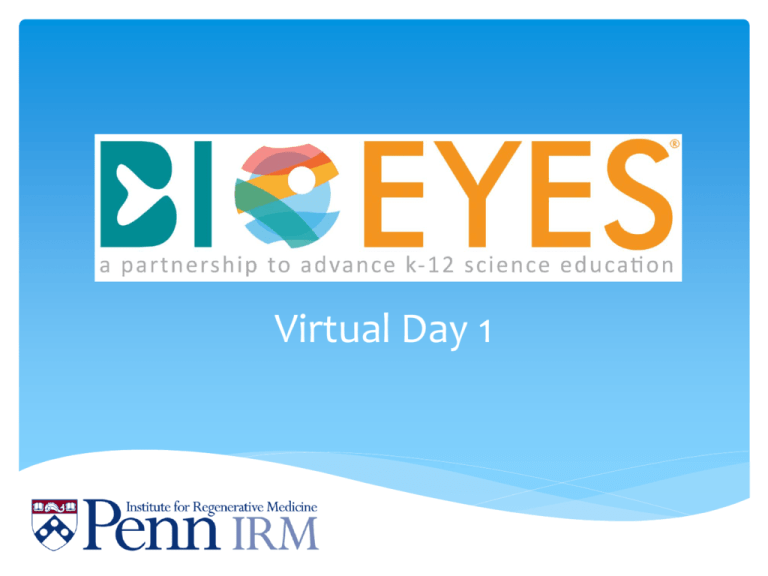Virtual Day One
advertisement

Virtual Day 1 Introductory Letter Hello scientists, Welcome to BioEYES! We are bringing you an exciting experiment. For the next week your goal will be to learn all you can about zebrafish and their similarities to humans. You will work with the zebrafish every day and record your findings (as all scientists do) in this journal, then collect data to come to a conclusion. This will take good observation skills and all of us at BioEYES believe you will do a good job and learn some very interesting things. Now that you have entered the world of science, there are a few ground rules that apply to all scientists. First, when working with live organisms, you must be careful to take good care of them and treat them with respect. Second, a good investigator is very thorough, so write down everything you observe. And don’t forget to have fun! Best of luck to you this week, TEAM BioEYES Scientific Process Put these 5 steps to the scientific process in order. Answer: Ask a Question, Formulate a Hypothesis, Conduct Experiment, Collect data, Draw a Conclusion Directions On the following two slides you will read and learn about zebrafish. After reading the slides, record 3-5 general facts about zebrafish. You can bullet point these facts. Answer the following question, “Why do we use zebrafish in research?” What Are Zebrafish? Danio rerio is the scientific name for the common zebrafish. These 1-2 inch tropical freshwater fish are found naturally or native to the Ganges River region of East India and to other nearby countries. They are known to eat small living organisms like plankton and insects and are themselves eaten by larger fish, birds, and eels. These fish are favorites of hobbyists and are sold throughout the world in pet stores. Zebrafish are also used by scientists as a model organism for scientific research. Why do we use zebrafish in research? Zebrafish share many traits with humans. Like all living things, they contain deoxyribonucleic acid (DNA) which contains the instructions for making proteins. Proteins are the key building blocks of all living organisms. Scientists refer to these instructions encoded in DNA as “genes.” Scientists have found that the DNA code (sequence) of a zebrafish gene is often very similar to the sequence of a human gene. Not surprisingly, many aspects of a zebrafish are similar to a human such as the cellular structure that makes up the eyes, heart, and pigmentation of the skin. In order to better understand the function of genes as well as how genes influence human diseases, scientists study smaller and less complex living things. Ideally, these model organisms grow and reproduce quickly, and they produce many offspring. Zebrafish larvae have the extra advantage of being optically clear to those observing their development. Scientists have successfully used the zebrafish as a model to better understand lipid metabolism, cell regeneration, and stem cells. Phenotypes of Adult Fish On your piece of paper, make observations about the phenotypes of these two adult fish. (Hint: phenotype means “outward appearance”) Photos: www.bio-atlas.psu.edu www.zebrafish.co.kr Explanation of Phenotypes This is what we call a “wild type” zebrafish because it has the look that we most often see in the wild. Its dominant trait of having stripes and dark eyes is common to the species. This fish is male. We know that because it has a slim body shape. Note: Not all wild type zebrafish are males. Females can be wild type as well. Explanation of Phenotypes This fish is albino. It has a mutation in its DNA that results in the inability to produce melanin. As you can see this fish does not have any dark pigment. Its phenotype is rare in the species. This fish is also female. We know that because it has a round underbelly which is where she stores her eggs! Note: Not all albino zebrafish are females. Males can be albino as well. Scientific Question & Hypothesis Directions: Write down the scientific question and make a hypothesis. Scientific Question: If you cross/mate a wild type zebrafish with an albino zebrafish, what will be the phenotype of the offspring? (What will the offspring look like?) Hypothesis: Answers will vary Video of Zebrafish Mating https://www.youtube.com/watch?v=erfzIoZ5qNQ Note: Zebrafish eggs undergo external fertilization. If you pay close attention you will see small white/clear round eggs that are released from the female in short bursts. The male fish must stay close by as he must fertilize the eggs once they are released into the water. Optional: “Will This Fish Transform Medicine?” article http://www.popsci.com/science/article/2013-01/will-fishtransform-medicine







